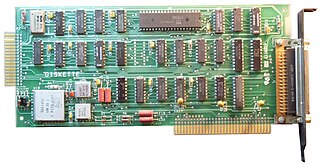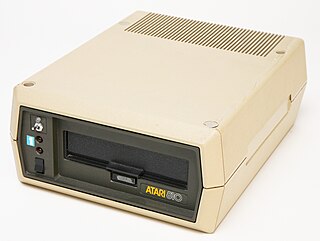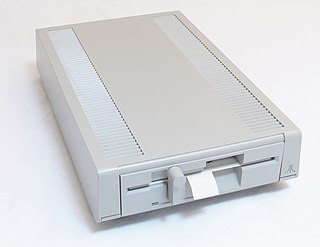A disk operating system (DOS) is a computer operating system that resides on and can use a disk storage device, such as a floppy disk, hard disk drive, or optical disc. A disk operating system provides a file system for organizing, reading, and writing files on the storage disk, and a means for loading and running programs stored on that disk. Strictly speaking, this definition does not include any other functionality, so it does not apply to more complex OSes, such as Microsoft Windows, and is more appropriately used only for older generations of operating systems.

A floppy disk or floppy diskette is a type of disk storage composed of a thin and flexible disk of a magnetic storage medium in a square or nearly square plastic enclosure lined with a fabric that removes dust particles from the spinning disk. Floppy disks store digital data which can be read and written when the disk is inserted into a floppy disk drive (FDD) connected to or inside a computer or other device.

The IBM Personal Computer is the first microcomputer released in the IBM PC model line and the basis for the IBM PC compatible de facto standard. Released on August 12, 1981, it was created by a team of engineers and designers at International Business Machines (IBM), directed by William C. Lowe and Philip Don Estridge in Boca Raton, Florida.

The TRS-80 Micro Computer System is a desktop microcomputer launched in 1977 and sold by Tandy Corporation through their Radio Shack stores. The name is an abbreviation of Tandy Radio Shack, Z80 [microprocessor]. It is one of the earliest mass-produced and mass-marketed retail home computers.

Shugart Associates was a computer peripheral manufacturer that dominated the floppy disk drive market in the late 1970s and is famous for introducing the 5+1⁄4-inch "Minifloppy" floppy disk drive. In 1979 it was one of the first companies to introduce a hard disk drive form factor compatible with a floppy disk drive, the SA1000 form factor compatible with the 8-inch floppy drive form factor.

The Acorn System was a series of modular microcomputer systems based on rack-mounted Eurocards developed by Acorn Computers from 1979 to 1982, aimed primarily at industrial and laboratory use, but also home enthusiasts.

The FD1771, sometimes WD1771, is a floppy disk controller chip produced by Western Digital. It is the first in a line of floppy disk controllers that Western Digital produced. It uses single density FM encoding introduced in the IBM 3740. Later models in the series added support for MFM encoding and increasingly added onboard circuitry that formerly had to be implemented in external components. Originally packaged as 40-pin dual in-line package (DIP) format, later models moved to a 28-pin format that further lowered implementation costs.
Pertec Computer Corporation (PCC), formerly Peripheral Equipment Corporation (PEC), was a computer company based in Chatsworth, California which originally designed and manufactured peripherals such as floppy drives, tape drives, instrumentation control and other hardware for computers.

A floppy-disk controller (FDC) is a hardware component that directs and controls reading from and writing to a computer's floppy disk drive (FDD). It has evolved from a discrete set of components on one or more circuit boards to a special-purpose integrated circuit or a component thereof. An FDC is responsible for reading data presented from the host computer and converting it to the drive's on-disk format using one of a number of encoding schemes, like FM encoding or MFM encoding, and reading those formats and returning it to its original binary values.
Atari 8-bit computer peripherals include floppy drives, printers, modems, and video game controllers for Atari 8-bit computers, which includes the 400/800, XL, XE, and XEGS.

A floppy disk is a disk storage medium composed of a thin and flexible magnetic storage medium encased in a rectangular plastic carrier. It is read and written using a floppy disk drive (FDD). Floppy disks were an almost universal data format from the 1970s into the 1990s, used for primary data storage as well as for backup and data transfers between computers.

The TRS-80 Model II is a computer system launched by Tandy in October 1979, and targeted at the small-business market. It is not an upgrade of the original TRS-80 Model I, but a new system.

The APC was a series of business microcomputers released outside of Japan by the NEC Corporation. The series comprised the APC, the APC II and APC III, international versions of models from the Japanese NEC N5200 series(jp).

Home computers were a class of microcomputers that entered the market in 1977 and became common during the 1980s. They were marketed to consumers as affordable and accessible computers that, for the first time, were intended for the use of a single, non-technical user. These computers were a distinct market segment that typically cost much less than business, scientific, or engineering-oriented computers of the time, such as those running CP/M or the IBM PC, and were generally less powerful in terms of memory and expandability. However, a home computer often had better graphics and sound than contemporary business computers. Their most common uses were word processing, playing video games, and programming.

The floppy disk is a data storage and transfer medium that was ubiquitous from the mid-1970s well into the 2000s. Besides the 3½-inch and 5¼-inch formats used in IBM PC compatible systems, or the 8-inch format that preceded them, many proprietary floppy disk formats were developed, either using a different disk design or special layout and encoding methods for the data held on the disk.

The Atari 810 is the official floppy disk drive for the Atari 400 and 800, the first two models of Atari 8-bit computers. It was released by Atari, Inc. in 1980.

The Atari 1050 is a floppy disk drive for Atari 8-bit computers released in June 1983. It is compatible with the 90 kB single-density mode of the original Atari 810 it replaced, and added a new "enhanced" or "dual density" mode that provided 130 kB. Based on a half-height Tandon mechanism, it was smaller than the 810 and matched the styling of the new 600XL and 800XL machines.

The XF551 is a 5 1/4 inch floppy disk drive produced by Atari, Inc. for the Atari 8-bit computers. Introduced in 1987, it matches the gray design language of the XE models. It was the first drive from the company with official support for double-density and double-sided floppy disks—360 kB of storage per disk—and was also the final floppy disk drive Atari produced for the 8-bit computers. The XF551 allows faster transfer speed when used in double-density mode, doubling performance.
Parasitic Engineering, Inc., was an American computer company founded by Howard Fullmer and Gene Nardi in 1974. Named as a tongue-in-cheek reference to a comment by MITS co-founder Ed Roberts, Parasitic's first products were hardware upgrade kits to MITS' Altair 8800 microcomputer kit, improving the latter's power supply rating and susceptibility to noise. The company later released their own microcomputer based on the same bus as the Altair, the S-100, but it was less popular than the company's hardware-improvement kits. By 1979, the company had pivoted to providing upgrades to Tandy's TRS-80. Parasitic went defunct in 1983.

Jonos International, Inc., originally Jonos, Ltd. (JL), later Netcom Research, Inc., was an American computer company active from 1980 to 1992. The company sold a variety of computer hardware products and systems, including STD Bus peripherals, smart terminals, microcomputers, and portable computers. The company's Courier portable computer was the first microcomputer sold with Sony's then-new 3.5-inch floppy disk drives on its release in June 1982. Jonos' systems were widely used in the fields of construction, roadworks, machining, and military.
















